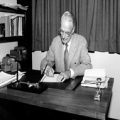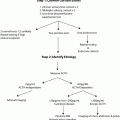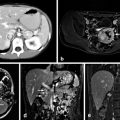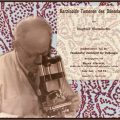Photograph of Cushing in his dressing room. Immediately following surgery, Cushing would illustrate the operative findings. It was common for him to wear his operative gloves while drawing these illustrations. (Photograph by Walter Willard Boyd. Courtesy of the Cushing-Whitney Medical Historical Library, Yale University School of Medicine, New Haven, CT)
There are few individuals who have profoundly changed the course of medical history. Harvey Cushing (1869–1939) is one of them. His contribution to modern neurosurgery , critical care anesthesia, surgical education, research, medical illustration, and literature including a Pulitzer Prize for his biography of Sir William Osler demonstrate his enormous span of influence. Two excellent sources documenting Cushing’s contributions and persona are the historical biography by John F. Fulton and the entertaining and insightful biography by Michael Bliss [1, 2].
Harvey William Cushing, the youngest of ten children, was born on April 8, 1869, in Cleveland, OH. His brother, father, grandfather, and great-grandfather were all physicians who profoundly influenced his career. He benefited from a privileged lineage and a family that emphasized the importance of education. As a child he avidly collected and catalogued insects, minerals, and plants. He also demonstrated precocious talent as an illustrator, a skill he would subsequently refine and incorporate into his career [3]. He attended Yale University from 1887–1891, played for the Yale baseball team and was elected into the secret society “Scroll and Key”.
He followed the lead of his brother Ned and attended Harvard Medical School from 1891 to 1895 where even as a medical student he made significant contributions including the creation and employment of the “ether chart” in 1894 and the implementation of X-rays that had been described 1 year earlier by Röntgen. Accordingly, he set the background for both critical care anesthesia and diagnostic radiology. He began his clinical training as a house pupil in Massachusetts General Hospital in 1895.
He left Boston to go to Baltimore in 1869, at the age of 27, to work as an assistant resident under the leadership of William S. Halsted of Johns Hopkins Hospital. At Hopkins, his clinical skills were enhanced and he also continued to refine his artistic talents under the tutelage of Max Brödel the founder of the Department of Art as Applied to Medicine and perhaps the greatest medical illustrator in the world [4]. Brödel’s genius is demonstrated in his illustration of Cushing’s approach to the pituitary gland (Fig. 1). Cushing took formal art lessons from Brödel and began a lifelong relationship with the master illustrator. Cushing became increasingly interested in intracranial surgery, but recognized that the inability to achieve hemostasis would limit the surgeon’s ability to perform resectional therapy. In typical Cushing fashion, he attacked the problem with insight and experimental creativity and refined and incorporated the operative use of suction and coagulation devices while working with the engineer William Bovie; he would subsequently develop a vascular clip (“Cushing clip”) to be applied to intracranial vessels. He developed the modern field of neurosurgery and every subsequent neurosurgeon can trace their training based on a lineage to Harvey Cushing . At Hopkins, he worked with the founding fathers of Johns Hopkins Hospital: William Stewart Halsted (Surgery), William Osler (Medicine), William Henry Welch (Pathology), and Howard Atwood Kelly (Obstetrics). Osler was both his neighbor and mentor. They became lifelong colleagues sharing a profound interest in clinical medicine, scientific discovery, and collecting ancient medical books including the works of his historical hero Vesalius.
Stay updated, free articles. Join our Telegram channel

Full access? Get Clinical Tree







